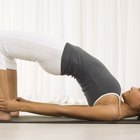
Falls are a serious danger for the elderly, often resulting in serious injury. Caregivers and family members must be prepared to lift a fallen elderly person without hurting the person or themselves. The techniques for lifting a person safely are similar to those used by weightlifters at the gym, designed to protect the lifter's back and balance.
Lifting

Always lift heavy weights by using the strength of your legs rather than your back. To lift a fallen person, face them with your feet at shoulder width. Bend your knees to lower yourself into a squat, keeping your back straight. Gently maneuver your hands and arms under the person, and grasp him with your palms upward. Press evenly into the ground with both feet, and straighten your legs, making sure your back does not bend.
Carrying
Hold the person against your body at waist level. Keeping them at your center of gravity like this protects your back. Turn by moving your feet, keeping your body vertically aligned. Do not twist your back to initiate a turn. To put the elderly person down again, reverse your lifting procedure: plant your feet evenly, and bend your knees. Keep your body vertical and the person against your waist. Lower from your legs, not your back or arms.
Precautions

According to AARP Health, 20 to 30 percent of falls by elderly people result in injury. Check the fallen person for injury before attempting to lift her. If she is injured, she should not be moved without stabilization, so call paramedics to move her instead of doing it yourself. Only move an injured person if he is in danger where he is, for instance, if the room is on fire. If you have the choice, wear loose clothing and flat shoes when you lift an elderly person.
Prevention

People over the age of 65 can minimize the danger of falling by taking care of themselves and their homes. The elderly should regularly practice strength training to build coordination and improve balance. They should keep their floors clear of clutter, install handles and slip-proof floors in baths and showers and always use handrails when going up and down stairs. They can also reduce their chances of falling by regularly seeing an eye doctor and making sure that any medications they are on combine safely.
Related Articles

How to Measure Legs

How to Get a Senior Into a SUV

Proper Way to Use a Foil Shaver

How to Prevent Underarm Bumps

Different Positions for a Tanning Bed

How to Curl Eyelashes Without Pinching ...

How to Measure Body Width

How to Shave Leg Stubble

What Is the Cup Size of Someone With a ...

Swollen Lymph Nodes in Horses

How to Measure a Waist

Can Large Pores on the Legs be ...

How to Put on Padded Bike Shorts

Galvanic Cellulite Treatment

Anti-Aging Face Exercises

How to Barbecue Turkey Legs in Foil

Easy Exercises to Tighten Loose Skin

How to Size Compression Shorts

How to Make Hair on the Upper Lip Stop ...

How to Tighten Loose Ligaments
References
Resources
Writer Bio
Stephanie Mitchell is a professional writer who has authored websites and articles for real estate agents, self-help coaches and casting directors. Mitchell also regularly edits websites, business correspondence, resumes and full-length manuscripts. She graduated from Syracuse University in 2007 with a Bachelor of Fine Arts in musical theater.
Photo Credits
Stockbyte/Stockbyte/Getty Images